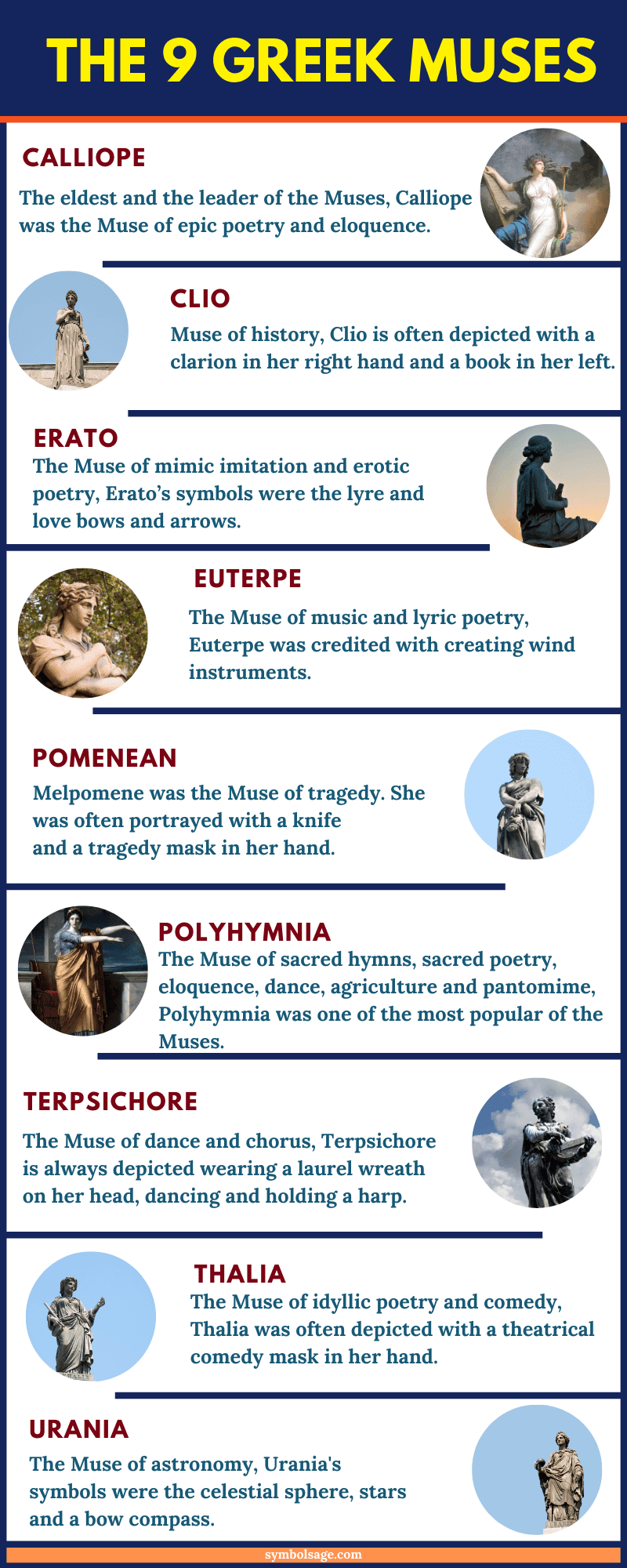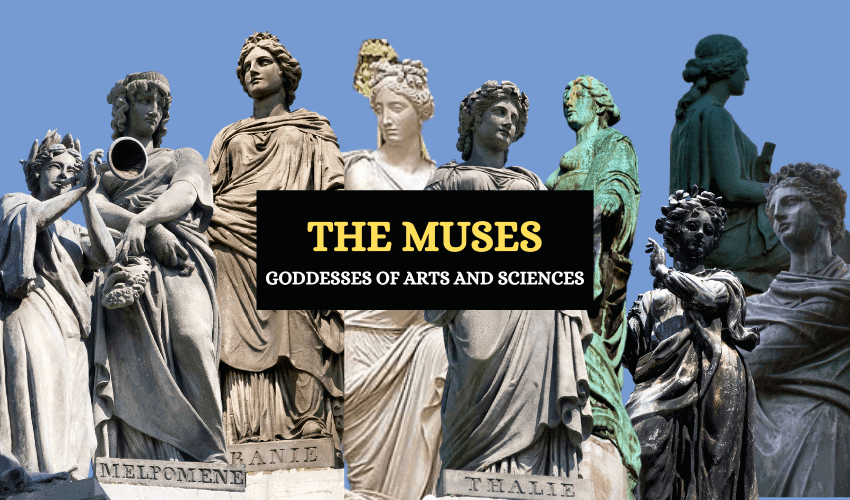Symbols Of The Muses Stars Symbol 9 Greek Atre Masks Muse
The gifts, appearances and symbols of the muses. This article will explore the origins, meanings, and significance of the symbols of the muses. There were nine muses, each with her own talents and attributes.
The Nine Muses in Greek Mythology Symbol Sage
Here are descriptions of each muse, including what they represented, some of their physical descriptions and symbolic items. Each muse has a unique set of symbols that reflect her domain, making them an essential part of the cultural heritage of the ancient world. Calliope was the chief of the nine muses and the patron of poetry.
She was the mother or orpheus.
The muses gifts, appearances, and symbols. There were nine muses, all with their own unique talents and attributes. Here are descriptions of each muse, including what they represented, some of their physical descriptions, and symbolic items. Calliope was the chief of the nine muses and the patron of poetry.
She was the mother or orpheus. Each of the nine muses is associated with a different domain: The muse of epic poetry. Her symbols are a writing tablet and stylus.

Her symbol is usually a scroll or a set of tablets.
The muse of lyric and love poetry. She’s often depicted with a lyre. The muse of music and lyric poetry The muses have different symbols that are emblematic of their domains.
For instance, calliope is often seen with a writing tablet, urania with a globe and compass, and clio with a lyre. These symbols serve as visual cues, helping us to instantly recognize which muse we’re encountering in art or literature. Modern interpretations of the muses continue to resonate in contemporary culture. Artists, writers, and creators frequently refer to the muses as symbols of inspiration, seeking their guidance in various forms of expression.

The idea of “finding one’s muse” has become a common phrase, representing the search for creative motivation.
Terpsichore is typically depicted either dancing or seated while playing the lyre, which is an important symbol of muses in general. On a statue found in hadrian’s villa, she is depicted with the lyre tucked under her arm and a feathered headdress. Polyhymnia was one of the nine muses, the ancient greek goddesses of music, song and dance. In the classical era, when the muses were assigned specific artistic and literary spheres, polyhymnia was named muse of religious hymns and portrayed as a woman in a pensive or meditative pose.
The renaissance, a period of renewed interest in classical antiquity, saw a revival of the muses in art and literature. This is because she holds a cherry stem, a symbol of justice with which calliope is often associated. Symbols of mnemosyne and the nine muses, greek mosaic from elis c1st b.c., archaeological museum of elis. Hesiod, theogony 915 ff (trans.

And again, he [zeus, after lying with demeter] loved mnemosyne with the beautiful hair:
Tragedies and comedies performed in honor of the muses during festivals. The impact on literature, music, and visual arts. The influence of apollo and the muses extends beyond visual arts to literature and music. Poets like homer and hesiod invoked the muses for inspiration, while musicians sought apollo’s favor for their compositions.
Conversely, thalia's sister, melpomene became distinguished as the greek muse of tragedy during the greek classical era. Not much is known about her, but in artistic interpretations, she held a Melpomene was one of the nine muses, the ancient greek goddesses of music, song and dance. In the classical era, when the mousai were assigned specific artistic and literary spheres, melpomene was named muse of tragedy.

In this guise she was portrayed holding a tragic mask or sword, and sometimes wearing a wreath of ivy and cothurnus boots.
More often than not, the muse erato is seen as wearing a crown of myrtle and holding a lyre, an instrument considered to be one of the symbols of apollo. By the renaissance, erato’s symbols became conflated with those that would have been traditionally saved for aphrodite. Euterpe is the inimitable muse of music and lyrical As a group they were known as the younger muses.
They turned mount pierus into one of their homes and had their own sphere of influence in the arts. Because mnemosyne was the mother of the younger muses, she’s often confused with mnema, a greek goddess who was one of the elder muses. Since mnema was also a goddess of memory, the two were The muses were also central to roman education, serving as symbols of the liberal arts.
Philosophers and educators sought to emulate the muses’ inspiration in their teachings, leading to a rich cultural legacy that would influence future generations.
Muse of epic poetry (and eloquence). Her symbol is the writing tablet or the book. She, the eldest among the muses, is the mother of orpheus (and linus). Homer invokes her as his muse in the iliad and the odyssey.
She favored achilles and taught him how to entertain his friends by singing at feasts. In contemporary culture, the muses continue to inspire various media, including film, literature, and music. They serve as symbols of creativity and the human pursuit of excellence in artistic expression. The muses and their modern interpretations.
In today’s creative fields, the muses remain relevant as symbols of inspiration and
The muses then used sirens’ feathers to make crowns for themselves. The pierides, or the nine daughters of king pieros of emathia, each given the name of one of the muses, also challenged the muses to a contest of song. They lost it, and the muses took revenge on them by turning them into magpies.’ Polyhymnia was the youngest of the nine muses, who were the goddesses of science and the arts.
She was the muse of poetry, music and dance. He asked the muses to help him tell the stories of the iliad and odyssey and the muses became symbols of inspiration and artistic creation. The influence of the muses can be seen in later artistic movements, including the renaissance, where artists like botticelli depicted the muses as symbols of inspiration in their works. Muses in literature and philosophy a.
References to muses in ancient greek literature
In ancient greek religion and mythology, the muses (ancient greek: Múses) were the inspirational goddesses of literature, science, and the arts. This circular mosaic is decorated with the names and symbols of apollo, mnemosyne and the nine muses. The muses were credited with inspiring some of the greatest art, poetry and music created by mortal men and women throughout history.
As minor goddesses of the greek pantheon, they hardly ever featured in their own myths individually. Which were the symbols of the muses? The muses ' symbols were the lyre, the scrolls, the globe, the writing tablet, the comic and tragic mask and the flute.